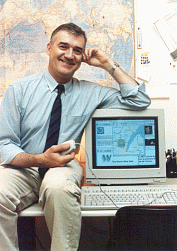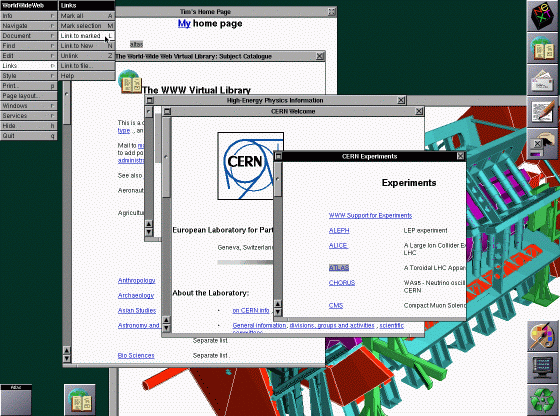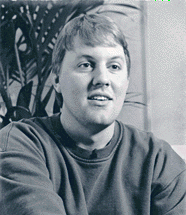
If you are interested in the things that happened before Tim Berners-Lee entered the stage (i. e. the history of hypertext), you might want to check out the first part of this text by Shunfeng Zang.
 | Tim Berners-Lee was born on June 8, 1955, in London. He studied physics in Oxford, and in 1980, a few years after his graduation, he began working as a consultant at the CERN (European Laboratory for Particle Physics / Centre/Conseil Européen pour la Recherche Nucléaire) in Geneva. During this time he got annoyed with the fact that all his information was stored in different, separate, self-contained databases and that he was not able to save his data in the way human brains normally work, that is by random associations between different ideas and concepts. Therefore, he wrote a program called ENQUIRE (named after a Victorian how-to book called Enquire- within-upon-everything) which made it possible to create typed links between different nodes of information within a single file and across file-boundaries in a file system. ENQUIRE was mainly used by Tim Berners-Lee himself to keep track of his projects, and although it has never been published, ENQUIRE forms the conceptual basis of the World Wide Web. In 1981, Tim Berners-Lee left CERN for a short time, but in 1984, he took up a fellowship at CERN and worked among other things on a heterogeneous remote procedure call system, thus acquiring some experience in network and socket programming which became useful later on. |
 |
In the meantime, TCP/IP was introduced at CERN, and in 1989 the CERN
was the largest Internet site in Europe. However, Tim Berners-Lee felt that
the CERN had a problem: Being a complex and vivid place, where many
intelligent and productive scientists worked, CERN produced a lot of
knowledge that was stored in many different, separate databases. When a new
person joined the community, it was a very difficult task for him or her to get
acquainted with the facilities and people of which it consisted, thus
losing a lot of time. Moreover, information could easily get lost. With
this situation on his mind, Tim Berners-Lee submitted
Information Management - a Proposal to his superiors in 1989, a paper in which he
described the problems he observed and suggested to develop a hypertext-based
system to solve them, as hypertext would make it possible to create
free links between different nodes of information and would not put any
restraints on the information it stored as hierarchical systems do. The
system was supposed to fulfill the following requirements: |
In his proposal, Tim Berners-Lee explicitly stated that copyright enforcement and data security were not a design issue for this proposed system, as CERN mainly is based on free information interchange. The above requirements made it natural to divide the system into two parts, a browser and a server, that communicate via a standardized protocol over the network. At first, the proposal was not supported completely, but when it was recirculated in 1990, Tim Berners-Lee's boss told him to go ahead with the project. Thus, in November 1990, TBL started working on WorldWideWeb (the first graphical browser and what-you-see-is-what-you-get HTML editor) and httpd (the first HTTP server). Furthermore, he designed HTML (the HyperText Markup Language), HTTP (HyperText Transfer Protocol) and the URL (Uniform Resource Locator, also called UDI (Universal Document Identifier) or URI (Universal Resource Identifier)). In his work, he was assisted by Robert Cailliau, one of his friends who also worked at CERN and contributed a lot to the early development of the World Wide Web. The browser/editor WorldWideWeb was later renamed Nexus lest it should be confounded with the World Wide Web itself. Both WorldWideWeb and http ran under NeXTStep, an operating system developed by NeXT[1] for use on the NeXT-cubes, which provided a new object oriented environment and Rapid Application Development tools that greatly simplified the task of coding the WorldWideWeb, but which also made it extremely difficult to port the original browser to other operating systems (that is why it is not used as a standard browser today).

World Wide Web also became the name of the project itself (other names considered where Mine of Information (MoI), The Information Mine (TiM), and Information Mesh). In December 1990, the WorldWideWeb was demonstrable and in 1991, the WWW project and source code was made public, so that other programmers could develop their own browsers. For example, there were the Finnish Erwise browser, ViolaWWW, written by Pei Wei in Berkeley, and Midas, developed by Tony Johnson at SLAC, all of them running under X-Windows. According to Tim Berners-Lee, there was a time, when Viola was the best program to browse the web. By 1993, there were about 50 known HTTP servers and WWW traffic measured about 0.1 % of NSF backbone traffic. Also in 1993, the history of the World Wide Web reaches an important turning point, as we shall see soon.
Let us go back one year, as in 1992 another person, who is extremely important to the fast development and the success of the WWW, entered the stage: Marc Andreessen was a student and part-time assistant at the National Center for Supercomputing Applications (NCSA) at the University of Illinois, when he first came into contact with the World Wide Web.

 All the browsers
mentioned above ran on UNIX machines and did not have a
very user-friendly interface, which prevented the World Wide Web from
spreading rapidly outside the academic environment. Hence, Marc Andreessen
decided to write his own WWW-client software, that should be easier to use
and more graphically rich than the existing programs, and together with
Eric Bina, one of his friends at the NCSA, he developed a browser called
Mosaic,
which they published in early 1993. Mosaic had many killer
features: It was the first browser to properly support in-line images
(although there was a
All the browsers
mentioned above ran on UNIX machines and did not have a
very user-friendly interface, which prevented the World Wide Web from
spreading rapidly outside the academic environment. Hence, Marc Andreessen
decided to write his own WWW-client software, that should be easier to use
and more graphically rich than the existing programs, and together with
Eric Bina, one of his friends at the NCSA, he developed a browser called
Mosaic,
which they published in early 1993. Mosaic had many killer
features: It was the first browser to properly support in-line images
(although there was a <img> Tag in the original HTML, all the browsers
before Mosaic showed images in an extra window and not within the original
hypertext document). Furthermore, it was easy to install and easy to use,
and after finishing the coding, Andreessen offered a 24hr customer support.
Thus, unlike the other browsers of that time, Mosaic was not a private
project of a student, but it was intended to be used by many people.
The first version ran under X-Windows, but it was quickly ported to PC
(Windows 3.1) and Mac. Let us take a short break now and contemplate the
situation at this time. We have a still small but thriving global hypertext
system called the World Wide Web which offers the possibility to link
arbitrary pieces of information, and thus creating a virtual space of
knowledge. However, the World Wide Web has not really taken off and was
mainly used in an academic environment, as the client software was not
really user-friendly and ran under operating systems, that where not widely
used by the average home computer user. When Mosaic came along, this
situation changed entirely, as it offered a relatively consistent user-
interface and was available for the three most popular platforms of the
time. In addition to that, it was promoted hard by Marc Andreessen and the
NCSA and could be downloaded freely from the Internet. Thus, the popularity of Mosaic and the
Web soared and by September 1993, WWW traffic accounted for 1% of NSF
backbone traffic (still not too much, but 10 times as much as only 9 months
earlier). One month later, there were 200 WWW servers. In 1993, Marc
Andreessen graduated and left the NCSA for California. There he soon met
Jim Clark, the founder of Silicon Graphics, Inc., who had connections and
money, and after some consideration they came up with the plan to found a
start-up-company. Marc Andreessen got most of his old pals to join the
company, and in 1994 Mosaic Communications Corp. (MCOM) was officially
founded in Mountain Valley, California.
 The team had the task to create a new Mosaic from scratch, as the original
Mosaic had been developed at the NCSA and was its official property. The
new program was called Mosaic Navigator
and was published for download on the Internet on the 13 October 1994. The
programmers had added some extensions to the original HTML-Tags, which offered
web designers the possibility to implement some more
creative effects on their home pages. (Among these additions were tables
and frames, but I don't know if they were already implemented in the first
versions of Mosaic Navigator). Another new thing about Mosaic was the
retail concept: Officially, the browser had to be paid
for by non-students, but this policy was never really enforced, so that it
was basically available for free, a fact greatly contributing to its
success. Mosaic made its money with its web server and with
advertisements on its homepage, which was the default starting page of all its browsers.
However, there was a problem: The
University of Illinois claimed that MCOM had stolen Mosaic, of which it
held the rights. Thus, in December 1994, MCOM had to be renamed to
Netscape
Communications and the browser became the Netscape Navigator (which we all
know today), the University of Illinois got $3 million from Netscape and
did not make any further claims
The team had the task to create a new Mosaic from scratch, as the original
Mosaic had been developed at the NCSA and was its official property. The
new program was called Mosaic Navigator
and was published for download on the Internet on the 13 October 1994. The
programmers had added some extensions to the original HTML-Tags, which offered
web designers the possibility to implement some more
creative effects on their home pages. (Among these additions were tables
and frames, but I don't know if they were already implemented in the first
versions of Mosaic Navigator). Another new thing about Mosaic was the
retail concept: Officially, the browser had to be paid
for by non-students, but this policy was never really enforced, so that it
was basically available for free, a fact greatly contributing to its
success. Mosaic made its money with its web server and with
advertisements on its homepage, which was the default starting page of all its browsers.
However, there was a problem: The
University of Illinois claimed that MCOM had stolen Mosaic, of which it
held the rights. Thus, in December 1994, MCOM had to be renamed to
Netscape
Communications and the browser became the Netscape Navigator (which we all
know today), the University of Illinois got $3 million from Netscape and
did not make any further claims
In the same year, the W3C (Word Wide Web Consortium) was founded to define and promote the standards related to the World Wide Web. Tim Berners-Lee became its director and manages teams at the MIT in the USA, the INRIA (Institut National de Recherche en Informatique et en Automatique) in France and at Keio University, Japan (at this University Ted Nelson, whom we met before, works today). The W3C merely makes recommendations about new standards. Everybody can make changes and additions in any way he wants. This is done because the success of the World Wide Web is due to the fact that it is an open system, which is not owned or controlled by a single company or organization.
During the following two years, Netscape became the browser of choice of most Web surfers. In 1996, an incredible 75% of Web users ran Netscape on their computers. But alas, dark clouds loomed in the future.
And who else could personify these dark clouds but Bill Gates? Until 1995, Microsoft had completely underestimated the potential of the Internet and its fastest growing part and killer application, the Web. There a rumors that Bill Gates himself did not mention the Internet with a single word in his visionary book The Road Ahead (first edition). Although these rumors do not seem to be true, it remains a fact that Microsoft concentrated on its own proprietary network MSN (which was intended to be like CompuServe or AOL), not heeding the World Wide Web until it was nearly too late. When Microsoft realized the importance of the Web in 1995, it tried to make a deal with Netscape and to licence the Navigator. Jim Clark, however, refused the offer and therefore Microsoft began to develop its own web browser, the Internet Explorer, which ran under Windows 95 and was released in August 1995. A version for Windows 3.1 and Mac followed soon. Only three months later, Internet Explorer 2.0 was released. And another month later, Netscape released its Navigator 2.0. This was the beginning of the so called browser war. Microsoft used all its marketing power to promote the Internet Explorer. It was bundled with the popular operating system Windows 95, making it impossible to purchase a copy of Windows 95 without the Internet Explorer. When a US-Court told Microsoft to stop this practice, the Internet Explorer became and integral part of the Explorer, the user interface of Windows 98. Netscape, on the other hand, lost ground, and slowly but surely, the Internet Explorer became the more popular browser. This was not only due to Microsoft's strength, but also Netscape's own mistakes. Netscape overestimated its own dominant position and neglected the further development of the Navigator, the latest releases of which were quite buggy, whereas the quality of the Internet Explorer improved steadily.
In 1999, Netscape was bought by America Online, which does not use Netscape Navigator as its official browser. The source code of Navigator was published under the Mozilla license, which means that it is basically open source, but that Netscape retains the right to use the new code in its own commercial products. Mozilla is still developed by an Open Source community. Microsoft has won the browser war, but its legal aftermath turned out to be quite dangerous to the whole company. The browser war made the Department of Justice curious and led to a long trial which resulted in the verdict that Microsoft was abusing its monopoly and that Microsoft should be split. The court battle is still not over, although it seems that the new Bush administration is much more in favor of Microsoft, so that Microsoft could possibly succeed in revising the verdict. Actually, an appeals court overturned the original verdict in June 2001, and ruled that a new trial had to take place, which could end in an out-of-court agreement between Microsoft and the the now GOP led DOJ, which might be quite favorable for the company. (But these are vain speculations of the author of this text.)
In 1990 when Tim Berners-Lee created the World Wide Web, hypertext was not a new idea. In fact, there were quite a lot of companies that offered hypertext-based systems, so that TBL originally did not intend to create a new system from scratch, but to take an existing one and extend it for usage in a network environment. Ironically, none of these companies thought that hypertext and the Internet were a good match, and hence did not want to work together with TBL. When the basic WWW technology was finished, Tim Berners-Lee made it public and encouraged other developers to write their own browsers and to extend the technology just as they liked without having to be afraid of any punitive measures. In 1994, CERN's directors officially put the WWW in the public domain, making it freely usable to anyone with no fees being payable to CERN. In the same year, Mosaic was released, the program which boosted the popularity of the World Wide Web and made it accessible for a large audience. After that, the WWW kept continously growing and eventually roused the curiosity of large companies like Microsoft, which finally took over. However, the history of the World Wide Web is far from reaching its end. Many new technologies and developments lie ahead and hopefully the future of the World Wide Web will be as exciting and eventful as its past.
[1] NeXT was founded by Steve Jobs, the co-founder of Apple, and later on it was taken over by Apple. In 1990, NeXTStep was a very innovative operating system, and its last remainders can be found today in Mac OS X.